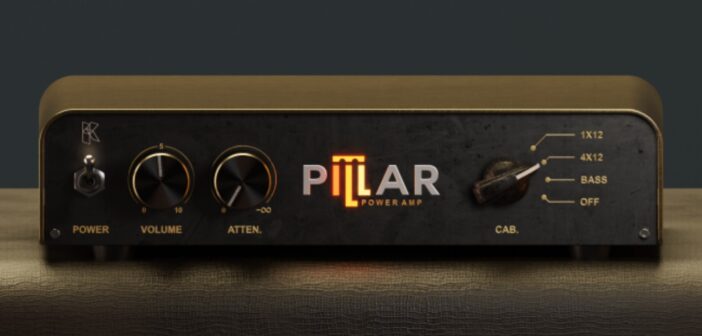Kuassa offers the Pillar Power Amp plugin as a free add-on with any Efektor Gainia purchase.
So far, 2023 has been a blessing regarding guitar plugins for your average axe slinger. The wizards over at Kuassa have been on fire this year as well, and the release of the Gainia preamps is a great addition to the currently available guitar plugins repertoire.
The even better news is that, along with purchasing any of the Gainia preamp plugins, you can access the Pillar power amp emulation for free.
Now, Pillar on its own isn’t going to do a whole lot to the sound of your guitar or bass. It has a trio of IRs, with a 1×12, 4×12, and 8×10 cabinet, all selectable. You can disable these if you’d like, using only the simulated tube to work with the preamp of your choice before going to an IR loader.
In practice, it sounds pretty nice, and I used it in conjunction with the high-gain Efektor Gainia XT and the default 4×12 cab option. You can ride the input a bit to simulate the breakup you might get from a power amp before it goes to the cab.
I also found that Pillar works quite well with the free JCM800 preamp on offer from Mercuriall, wherein you could build quite a low-cost bespoke amp sim of your choice with a few handy elements.
Pillar does offer 8x oversampling, which is handy for keeping the aliasing police at bay. You can also load it in as a module for the Amplifikation 360 suite to use it in all sorts of crazy chains.
Additionally, I did find it worked quite well in conjunction with Helix Stomp, loading just the preamp model for a handful of amps before sending the output on its way. Coupled with the free MIKKO2 IR which we covered a few months back, I could coax out quite a gnarly and pleasing sounding 5150 Block Letter sound.
As to whether or not you need a power amp emulation when Ignite Amps TPA-1 is still perfectly usable, I’d say that is solely up to your preference. I like the inclusion of the cab IRs. It’s a tidy and quick-to-use little package that has a quality all of its own.
You get Pillar for free when purchasing any of the Gainia preamps, as previously mentioned. They’re currently on sale for $9.99 at most plugin retailers, and you could likely knock the price down further if you have any credit available at Plugin Boutique.
Pillar is available for Windows and Mac computers. Supported plugin formats are VST, VST3, AAX, and AU. It is Apple Silicon native.
Download: Pillar Power Amp (Free with any purchase of Gainia preamp)
More:



11 Comments
harley_
on“(Free with any purchase of Gainia preamp)”
thats not free then if you have buy something else to get it first
mx
onwhat they meant when they said that it was free with any purchase of gainia preamp was that it is free with any purchase of gainia preamp actually.
Brenny C
onYou said it much more succinctly than I did. AND, unlike me, you correctly replied to the comment 😄
Brenny C
onSure it is. The plugin itself is free with the purchase of a $10 preamp plug. Yes, you’ve got to pay for the preamp in order to get Pillar Power Amp but that doesn’t make Pillar Power any less free!
Ike
onWould you be able to explain the difference between a “preamp” and a “power amp” in the context of guitar amplification?
mx
onthe preamp is the part of the guitaramplifier that actually is supposed to make the sound. here you find your preamp-gain, where you adjust your overdrive or distortion sound, and usually an eq or at least a tone control. after that the signal is passed on to the poweramp which is supposed to amplify that sound enough in order to drive a speaker.
fx loops in guitar amps are located between the preamp and the poweramp.
in theory the poweramp-stage is not there for shaping the sound, though it changes the sound as well. depending on what kind of circuit it is it changes it more or less, and particularly for guitaramps the sound of a driven (tube-)poweramp is a nice thing.
a poweramp is only needed if you want to hear your guitar from a speaker or if you want to put a mic in front of that speaker.
from a preamp you can go directly into an audio interface, a mixing desk or into guitar pedals, if theres no need for a speaker.
Ike
onThanks for the elaborate answer! I wonder whether it makes sense in the digital realm to have distinct plugins for “preamp” and “power amp” when it comes to guitar amplification, since we typically stay in the box and don’t want to power a guitar cabinet with a plugin. Am I missing something?
mx
oni guess most people playing guitar with software still build their guitarsounds with the same ingredients like in the real world, so an emulation of every part of a real world guitar signal chain makes sense for that approach.
every part of the signal chain contributes its own thing to the result and guitarists know what to use in which part of the chain and why.
so the simplest answer to your question is that powerampdistortion simply sounds different from preampdistortion (and it happens at different places in the chain).
there are also a lot of guitar pedals in the real world that try to emulate poweramp distortion, which also doesnt make sense in theory, when you go into a guitaramp consisting of pre- and poweramp.
but if it sounds nice it makes sense.
Ike
onThomann Beatmaking Contest and free Sample Pack:
https://www.thomann.de/blog/en/beatmaking-contest-thomann-bedroom-producers/
Numanoid
onQuietMusic has released a virtual kalimba: Klim
It costs $5 but is free with a code on their release page
Gery Zenz
oncode: 00KLIM